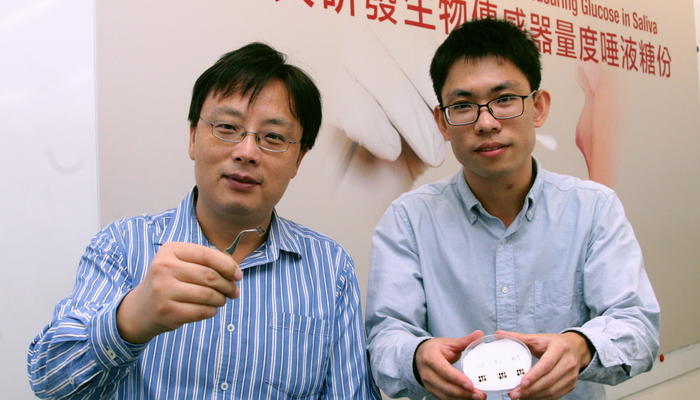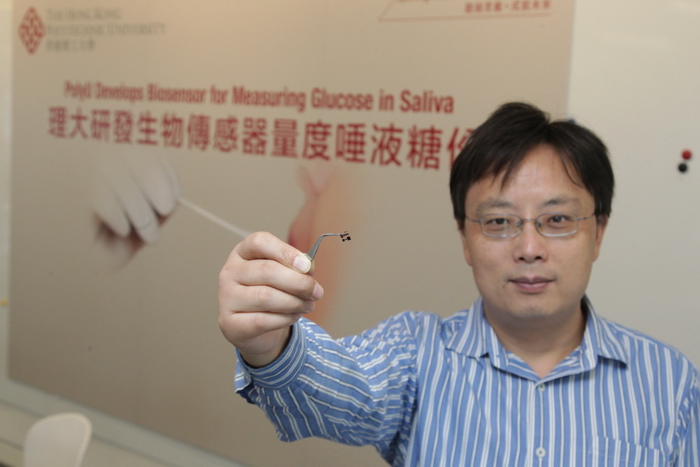Diabetic patients have to monitor blood glucose regularly and frequently, but conventional method of taking blood sample for measuring glucose level is painful. It is therefore important to develop high performance biological sensors for monitoring the glucose level at a reasonable cost. Recently, researchers in the Department of Applied Physics of The Hong Kong Polytechnic University (PolyU) have successfully developed an ultra-sensitive transistor-based biosensor which could detect glucose in saliva. The newly invented biosensor is highly sensitive to glucose and capable of measuring the range of glucose in saliva accurately in a convenient, safe and inexpensive manner.
The challenge to develop biosensor to test glucose in saliva is that the amount of glucose in saliva is too small for detection, and it requires a super sensitive biosensor to perform the job. The biosensor developed by PolyU researchers is fabricated with a glucose oxidase enzyme (GOx) layer, which is sensitive to glucose alone and nothing else. By detecting the electrical current, the glucose level can be known. However, there can be interference with current from other possible biological elements in saliva, such as dopamine, uric acid and ascorbic acid. To block such interference, researchers have coated Polyaniline (PANI) / Nafion-graphene bilayer films between the top enzyme layer and gate electrode. The strong adhesion of this top layer to the GOx layer enables the latter to stabilize and perform well in glucose detection.
Our novel biosensor is selectively sensitive to glucose, accurate, flexible and low in cost. The highly sensitive biosensor shows a detection lower limit of 10-5 mmol/L, which is nearly 1000 times sensitive than the conventional device for measuring blood glucose. This means with this biosensor, as little as 5 gram of glucose in a standard swimming pool of 50 m x 25 m x 2 m can be detected. Between the wide range of glucose level from 10-5 mmol/L up to 10 mmol/L (equivalent to 5 g – 5000 Kg of glucose in a standard swimming pool), the biosensor demonstrates linear response, which is good enough for measuring the possible range of glucose in the human body. Accuracy of the biosensor has been ascertained through laboratory experiments with repeatable results using glucose solutions of known glucose levels.
The glucose biosensor fabricated with flexible substrates can perform in a variety of curved and moving surfaces, including human skin, smart textile and medical bandage. Thus, it has great potential for development into wearable electronic applications, such as wearable biosensor for analysis of glucose level in sweat during exercise. It can also be mass produced at a low cost of HK$ 3 to 5 per test chip, which is comparable or even cheaper than the currently available commercialized products. In addition, this newly invented transistor-based biosensor platform is highly versatile. By changing to suitable enzymes, the platform can be used to measure the level of uric acid and other materials in saliva. For instance, if the biosensor is fabricated with enzyme uricase (UOx) and Polyaniline (PANI) / Nafion-graphene bilayer films, the platform can specifically be sensitive to uric acid only and other interference signals can be blocked.
The research findings on this high performance biosensors for saliva testing was published in the top material journal Advanced Materials.
*****

